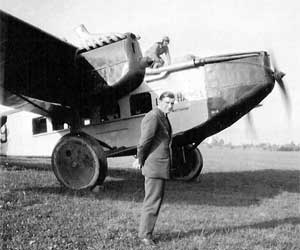Rohrbach Roland
| Ro VIII Roland | |
|---|---|
 |
|
| Role | Airliner |
| National origin | Germany |
| Manufacturer | Rohrbach |
| Designer | Adolf Rohrbach |
| First flight | 1926 |
| Primary user | Deutsche Luft Hansa |
| Number built | 18 |
The Rohrbach Ro VIII Roland was an airliner produced in Germany during the 1920s. It was a conventional strut-braced, high-wing monoplane, based loosely on the Zeppelin-Staaken E-4/20 that Adolf Rohrbach designed in 1920. It had a fully enclosed flight deck and passenger cabin, and featured fixed, tailskid undercarriage. Power was supplied by three engines, one in the nose, and two mounted in nacelles on the wings. Construction was of metal throughout.
In 1926 Deutsche Luft Hansa purchased the prototype Roland, followed by five production examples over that year and the next. The production machines were built with open flight decks, although they were later enclosed, as on the prototype. These were put to work servicing a route between Berlin and London via Hanover and Amsterdam. In July 1927 the Roland held the world endurance record for a payload of 1,000 kg with a flight of 14 hours 23 minutes, and the world distance record for a payload of 2,000 kg of 1,750 km (1,090 mi). At different times, the Roland held twenty-two world records.
In 1928, Luft Hansa replaced three of its Rolands with new machines of slightly different design. Designated Ro VIIIa, these had a fuselage that was stretched by 30 cm (1 ft) and were powered by the more powerful BMW V engines in place of the BMW IVs fitted to the prototype and first production batch. A new Spanish airline, Iberia, purchased the three Rolands that Luft Hansa retired, and put them into service on its inaugural service between Madrid and Barcelona.
In 1929, Rohrbach produced nine examples of a substantially updated Roland for Luft Hansa. These featured a major redesign of the flight deck, and a new wing design. Dubbed the Roland II, these aircraft continued in service with the airline until 1936 on its Hamburg–Malmö and Berlin–Munich routes. Luft Hansa sold at least three of these aircraft to Deruluft upon retirement. The Luftwaffe acquired another one, armed it, and operated it at the clandestine school at Lipetsk to train bomber crews.
...
Wikipedia
